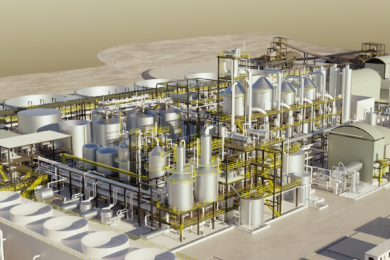Ioneer Ltd says it has moved one step closer toward construction at its Rhyolite Ridge lithium-boron site, following the Bureau of Land Management’s (BLM) planned issuance of the project’s draft Environmental Impact Statement (EIS).
The planned issuance – referenced in the BLM’s statement on April 12, 2024 – is the first to be issued from the Biden Administration as part of its efforts to accelerate domestic lithium production. It is the result of years of effective collaboration between Ioneer and federal, state and local agencies and Tribal Nations, the company says. It marks a key milestone in the environmental permitting review process for the proposed greenfield project in Esmeralda County, Nevada, set to inject a critical supply of integral transition materials into the US EV battery production supply chain.
The draft document will include Ioneer’s efforts to redesign and relocate proposed project activity away from Tiehm’s buckwheat, an endangered species classified by the U.S. Fish and Wildlife Service (FWS) in December 2022. The draft EIS will also detail Ioneer’s investments as part of a formal protection plan and propagation strategy for the Nevada plant.
The draft EIS will be available for public comment beginning April 19, with the company saying reaching this stage of the National Environmental Policy Act (NEPA) permitting process reflecting federal inter-agency collaboration and agreement that the draft document is ready for public input. Following the prescribed 45-day comment period, which will include BLM-organised public meetings, the BLM will incorporate feedback into a final draft and issue a final EIS and a Record of Decision (ROD), expected in October 2024. Upon issuance of a positive ROD, construction at Rhyolite Ridge can begin following a Final Investment Decision (FID). Based on that timeline, Ioneer anticipates production to begin in 2027.
Rhyolite Ridge is expected to be the first greenfield operation in North America to use AHS and will mark the expansion of Command for hauling automation technology to the 140 t class Cat 785 next generation mining truck. As stated in an October 2020 news release, the equipment, technology and services for the first five years of operation is valued at approximately $100 million and may be financed through Caterpillar Financial Services.
James Calaway, Ioneer’s Executive Chairman, said: “The forthcoming release of the draft EIS represents six years of hard work to help build America’s critical minerals supply chain and reaffirms the viability of our investment in Nevada. Rhyolite Ridge will help accelerate the electric vehicle transition and secure a cleaner future for our children and grandchildren. As we move through the final steps in the federal permitting process, Ioneer will keep working to ensure this world-class project will operate efficiently and sustainably.”
Bernard Rowe, Ioneer’s Managing Director, added: “This news sets a clear path forward to construction and brings us one step closer to making Rhyolite Ridge a reality. Rhyolite Ridge will be a significant, reliable and sustainable source of critical minerals for the United States. Ioneer is committed to working with the local community, Tribal Nations and state and federal agencies to help the U.S. secure a domestic supply of the critical minerals vital to the clean energy transition.”
Once operational, Ioneer’s Rhyolite Ridge lithium-boron project will be a leading example of responsible and sustainable mining. In July 2022, Ioneer submitted a revised plan of operations for federal permitting review, to avoid any direct impact to Tiehm’s buckwheat. After listing and designation of critical habitat, which the company supported, Ioneer worked closely with the agencies and stakeholders to develop a third iteration to detail plans to further reduce indirect impacts to the plant and reduce activity within designated critical habitat.
At the request of the BLM and FWS to further minimise impacts to the plant and its critical habitat, Ioneer’s revised design, set to be released on Friday, additionally changed the location of the quarry and overburden storage facilities to avoid any direct impacts to nearby subpopulations of Tiehm’s buckwheat and mitigate any potential indirect impacts.
To date, Ioneer has voluntarily invested $2.5 million in conservation efforts and committed an additional $1 million annually to ensure the plant and its surrounding habitat are protected. Ioneer will work to ensure the plant and its habitat for pollinators are protected as it works to transplant seedlings grown at its dedicated greenhouse.
Ioneer’s approach to water management also differs from other current and proposed domestic producers. Rhyolite Ridge will recycle half of all water used. The project will not have evaporation ponds or tailings dams and large parts of the quarry will be backfilled with overburden as mining progresses and ultimately concludes.










